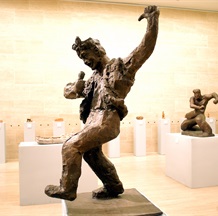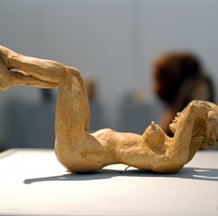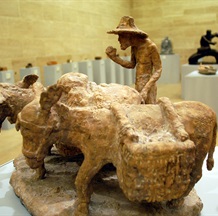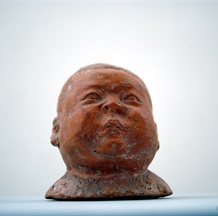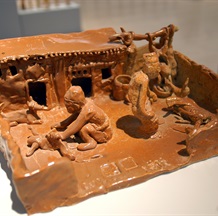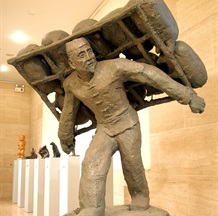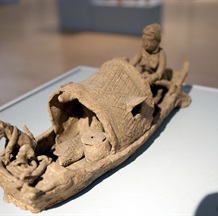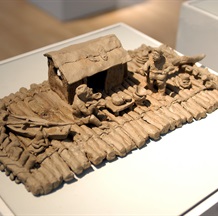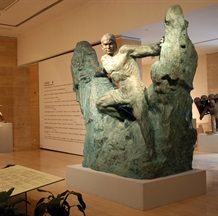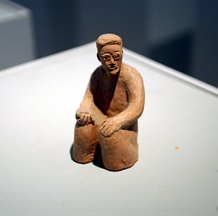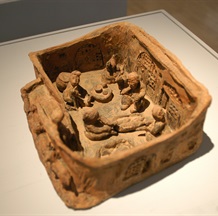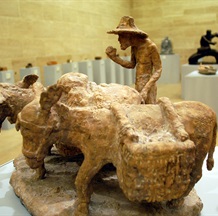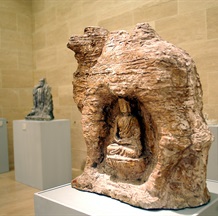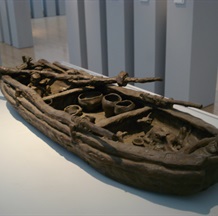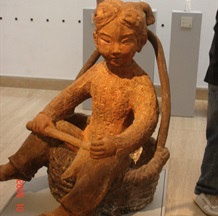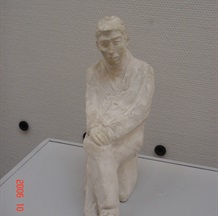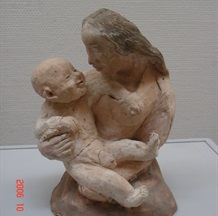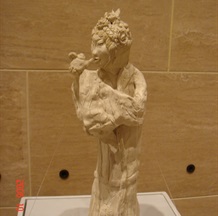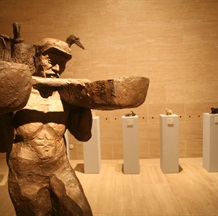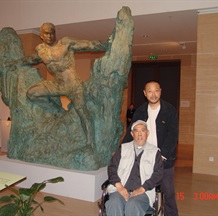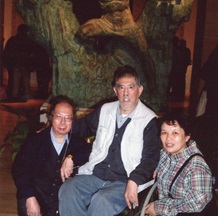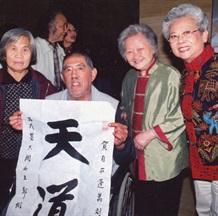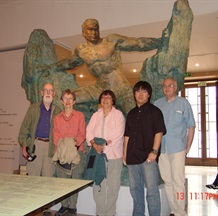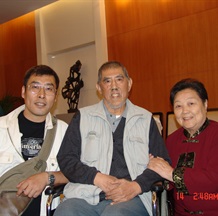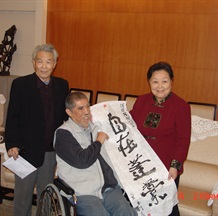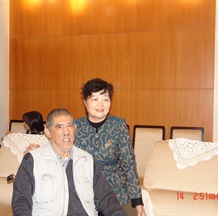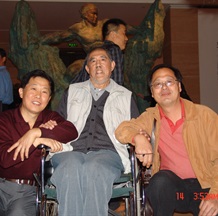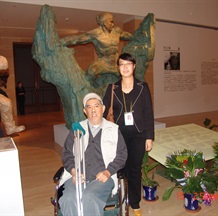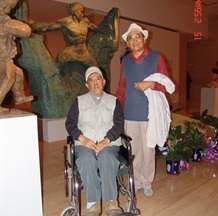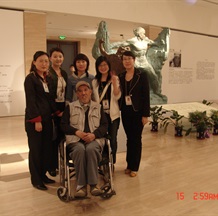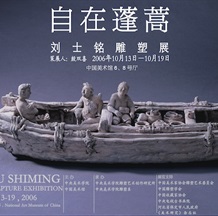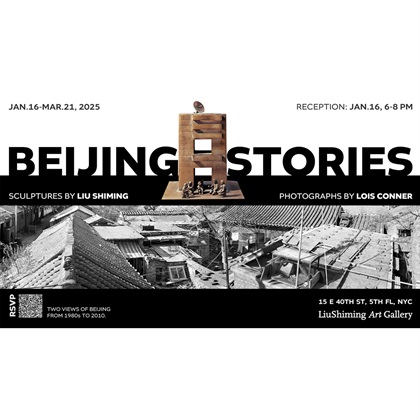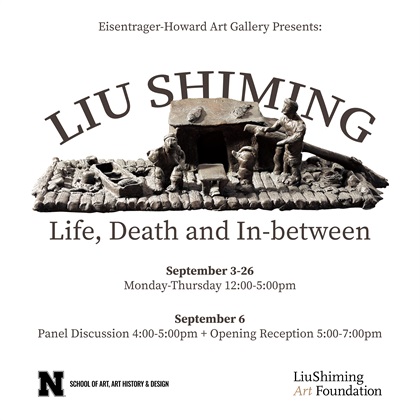The exhibition was hosted by the Central Academy of Fine Arts and the National Art Museum of China, organized by the Sculpture Art Institute of the Central Academy of Fine Arts and the Sculpture Department of the Central Academy of Fine Arts, and supported by the Sculpture Art Committee of the China Artists Association, the China Sculpture Institute, the China Association of Collectors, the Academy of Calligraphy and Painting of CCTV, the People's Government of Baoding Municipality, Hebei Province, and the magazine Fine Arts Research, and Prof. Yin Shuangxi, from the Central Academy of Fine Arts, served as the curator and host of the opening ceremony of the exhibition. The exhibition was accompanied by three main activities, namely the opening ceremony of the “Liberal Wormwood—Liu Shiming’s Solo Exhibition of Sculptures”; the “Golden Autumn Discovery” Chinese Sculpture Art Appreciation Session for Diplomats; and the Liu Shiming Sculpture Exhibition and the Symposium on the Connotation and Market Potential of Contemporary Sculpture.

The opening ceremony
Mr. Cao Chunsheng, Acting President of China Sculpture Institute, Mr. Sheng Yang, Director of Sculpture Art Committee of China Artists Association, Mr. Qian Shaowu, President of Professional Committee of Sculpture Art, China Arts and Crafts Society, Mr. Zeng Zhushao, Deputy Director of National Urban Sculpture Committee, Mr. Hou Yimin, President of China Mural Institute, Mr. Zou Peizhu, Chairman of Li Keyan Foundation, Mr. Yan Zhentang, President of China Association of Collectors, Mr. Yuan Yunsheng, Mr. Li Tianxiang, Mr. Jin Zhilin, Mr. Liu Jiahong, Mr. Liu Huanzhang, Mr. Sun Jiabao, Mr. Sui Jianguo, Mr. Lyu Pinchang and many other celebrities from the art world attended the ceremony. Mr. Liu Shiming, who is over 80 years old and has just recovered from a serious illness, came to the exhibition hall in a wheelchair and watched his first solo exhibition at the National Art Museum of China with his teachers, classmates and friends from all walks of life.Who is Liu Shiming? Looking back on the history of modern Chinese sculpture, it can be found that the name Liu Shiming has been associated with many significant events. One of his works in his student days, “Measuring the Land”, which reflected the land reform, was the first sculpture to be exhibited abroad after the founding of the People’s Republic of China, and was later collected by the National Museum of Czechoslovak (now the Czech National Museum). In 1952, as an assistant, he experienced the creation process of the sculpture of the Monument to the People’s Heroes. In 1959, his work “Splitting the Mountains to Let the Water Flow” (also known as “Moving Mountains and Making Seas”)participated on behalf of China in “the Plastic Arts Exhibition by Socialist Countries”, which was held in the Soviet Union. In 1997, “The Boat on Yellow River” was selected for the “National Ceramic Art Touring Exhibition” and “European Touring Exhibition”, and was collected by the Ministry of Culture of the People’s Republic of China.
Mr. Liu Shiming was born in Tianjin in 1926 and was admitted to the National Art School in Beiping, which was the predecessor of CAFA, in 1946. He became a member of the first group of sculpture students recruited by Prof. Xu Beihong himself, and was guided by Prof. Wang Linyi, Prof. Hua Tianyou and other famous teachers. In 1950, he graduated from CAFA with a bachelor’s degree. In 1951, he worked at CAFA after graduating from the postgraduate class. Since 1955, he has worked in the China Sculpture Factory, the Art Department of Kaifeng Normal College in Henan (now the Art Department of Henan University), the Hebei Baoding Mass Culture and Art Museum, National Museum of Chinese History (now the National Museum of China), and the Sculpture Department of CAFA. Mr. Liu Shiming was a member of China Artists Association, a member of the Chinese Sculptors’ Society, and an expert who enjoys the honour of the special contribution allowance of the State Council.
As a representative of the first generation of sculptors in New China, Mr. Liu Shiming has devoted his whole life to exploring the path of modern Chinese sculpture art and has made great artistic achievements.
Talking about his own artistic ideas, Liu Shiming argued, “Whether an artist’s work is valuable depends on whether he can reflect the era he lives in and portray the image of contemporary people or not. Sculpture art itself is people-oriented.”

Fan Di’an, Director of the National Art Museum of China, delivered a speech in the opening ceremony
Fan Di’an, Director of the National Art Museum of China, wrote in the preface to the exhibition that Mr. Liu Shiming “has been away from artistic trends and manifestations for many years, immersed in the rural memory of northern China and narrated alone. What he narrated are memories of his personal experience and of ordinary life. His sculpture career confronted the hollow and formatted creative mode with such sincere and specific memories, and his style of art reflected his independent personality and his spiritual home which he kept persistently.”The famous artist Qian Shaowu said that Liu Shiming’s identity has always been a part of the populace, and he loves, feels and sympathizes with everything from the perspective of the populace. He is very familiar with these things, and when he makes the sculptures, he can show his profound understanding.
Professor Yuan Yunsheng from the Department of Oil Painting, CAFA says, “All Liu Shiming’s works are the support of his emotions, personal life, and own spirit, and also a way for him to express, so they are real and simple.”
Sui Jianguo, Deputy Dean of the School of Fine Arts and Head of the Sculpture Department of CAFA, analyzed Liu Shiming’s sculpture art in the following way. “You will find it is a bit similar to an epic because it consists of many small stories, and in the end you will find that these stories cover a whole life. At that time, you will be touched. If you only see one small story, you will be touched but not very much. Through his works you can see his whole life.”
Shao Dazhen, a well-known art critic and professor at the Central Academy of Fine Arts, pointed out that Mr. Liu Shiming “can consciously use the traditional methods of ancient pottery sculpture in our country to break new ground in art, which is different from the ‘mainstream’ form of our current sculpture art, and this is undoubtedly a creative act of great insight and pioneering work.”

Aritist Liu shiming, delivered a speech in the opening ceremony
Mr. Liu Shiming wrote in his reflection on his solo exhibition, “Today, recalling my life, I have been through ups and downs...During ten years of wandering, I felt the most genuine love and joy, anger and frustration of many real working people and they expressed their emotions and love without any disguise. The images of these men and women are deeply engraved in my memory. They are also the inexhaustible resources of my inspiration, constantly stimulating my soul and memory. With my memory, I recorded the life and the people by making pottery sculptures. They are the emotional sustenance of my life, not just sculptures. I live and I record the age I am living in while happily making pottery sculptures of humans.”Mr. Liu believed that these sculptures, which embodied his lifelong emotions and wisdom, would not only inspire art professionals, but also shock the ordinary audience and find an echo in their hearts.
It was known that the exhibition would be on display until October 19.
Preface to the “Liberal Wormwood—Liu Shiming’s Solo Exhibition of Sculptures”
Liu Shiming was born into a family of intellectuals in Tianjin, and received the traditional education of Chinese literati. He was admitted to the National Art School in Beiping in 1946, and graduated from the postgraduate class of the Sculpture Department at the Central Academy of Fine Arts (CAFA) in 1951, under the guidance of renowned masters such as Prof. Wang Linyi, Prof. Hua Tianyou and Prof. Zeng Zhushao. In 1953, he was selected to the relief creation team for the Monument to the People’s Heroes in Tian’anmen Square, serving as the assistant to Prof. Liu Kaiqu and Prof. Wang Bingzhao, and he also participated in the drafting for the relief creation “Jintian Uprising”. He was one of the first generation of sculptors with a postgraduate background trained by the People’s Republic of China, and studied western art from a generation of sculptors from the Sculpture Department of the Central Academy of Fine Arts who had studied in France, especially Prof. Wang Linyi, who taught the introductory composition course and creation course, which benefited him a lot. However, he did not become a mainstream academic sculptor, but met the traditional Chinese art and folk art when he lived as one of the unprivileged people in Chinese society and began walking on an independent and boundless road of exploration. Today, when we approach this elderly man, we can’t help but be touched by his legendary life and the artworks that came from the bottom of his heart when we see the beautiful exhibition. He does not only embody the high aspiration and moral principles of Chinese intellectuals in the 20th century, but also reflects the difficult road of the development in Chinese sculpture in the 20th century, in which there are many phenomena worthy of being studied and thought about.
Liu Shiming’s sculptures make us think about whether the aesthetic judgment of Chinese contemporary sculpture should have its own criteria and value standards. What is the inner connotation of such criteria of value? What does it have to do with traditional Chinese aesthetic categories and concepts such as gu (bone), feng (style), shen (spirit), qi (vital force), and yun (charm)? I remember that Mr. Qian Shaowu once wrote an article in Fine Arts Research that talked about the artistic characteristics of traditional Chinese sculpture, especially qi, yun, feng and gu (powerful expressiveness and artistic impact that come from a literary work’s purity of thought and emotions, as well as from its meticulously crafted structure). This topic involves Chinese traditional culture, the reference of traditional art and the transformation in a contemporary era. The predecessors in the Chinese sculpture field, such as Zeng Zhushao, Hua Tianyou, Wang Linyi, Liu Kaiqu, etc., attached great importance to Chinese traditional culture, and have also made many valuable explorations. Today, how can we inherit their aesthetic ideals and develop contemporary Chinese sculpture? In this respect, Chinese sculptors have done a lot of work over more than half a century, and as a student of the first generation of Chinese sculptors who studied in France in the 20th century, Liu Shiming has made important contributions to this topic throughout his life and his retrospective exhibition enables us to see this historical mission more clearly. Studying Liu Shiming’s sculpture art in depth will broaden our horizon and enable us to realize although there should be various ways to develop Chinese sculpture, starting from Chinese local culture as a very worthwhile way of exploration.
In 2006, there were six artists holding large-scale solo sculpture exhibitions in the National Art Museum of China. Among them, the famous sculptor, who comes from Taiwan, Mr. Ju Ming found the imagery of sculpture from Chinese Taiji, Mr. Xiao Changzhi’s creations come from the images in natural space, Mr. Wen Lou from Hong Kong and Wu Weishan from Nanjing University focus on the representation of sages in Chinese history and famous scholars and artists in modern China, while Liu Shiming’s sculptures represent the underprivileged people in Chinese society, that is, the unknown small potatoes, and their common life. The holding of these sculpture exhibitions is meaningful. These large-scale exhibitions have their own characteristics, but in fact they have something in common, which is memorable. These exhibitions are related to the independent development of Chinese sculpture to different degrees, which is also related to the independent development of Chinese sculpture in the process of modernization in the 20th century, and it is related to how Chinese art in the 20th century found its cultural roots in the process of modernization and developed its own national artistic image in the global world of art, too. On the basis of our predecessors’ studying abroad, introducing and creating, and on the basis of the artistic exploration made by the sculptors I mentioned above, we can finally seriously discuss the historical topic, “modern Chinese sculpture” or “the modernity of Chinese sculpture” in the 21st century.
Curator: Dr. Yin Shuangxi
Liu Shiming: Self-Preface for the Exhibition
My professor, Mr. Wang Linyi, told me many times before that he wanted to see my sculpture exhibition, but unfortunately, he passed away in the summer of 1997. Recalling this, I can't help but wet my clothes with tears. I remember that at that time, I had returned to my alma mater, the Central Academy of Fine Arts, from the National Museum of Chinese History (now the National Museum of China), and apart from teaching, I spent most of my time creating in the ceramic studio of the Sculpture Department in the old campus of Central Academy of Fine Arts. Prof. Wang opened the door of the atelier of the Sculpture Department many times, entered the room, sat down, and said to me, “Your small sculptures are suitable for an exhibition, Liu Shiming. Make sure you look after them and don’t lose them.” Hearing this, I often smiled and didn’t respond directly. Let things go with the flow, I thought.
My life has been through ups and downs. I have a great passion for my life and love the customs I found along the Yellow River and on the Loess Plateau as well as in the cave dwellings in the Shannxi and Shanxi regions. I was fascinated by them, so, finally I went to the Central Plains. During the ten years of wandering, I felt genuine love, joy, anger and frustration of the most real labourers in life and they expressed their emotions and love without any disguise.The images of these men and women are deeply etched in my memory. They are also the inexhaustible resources of my inspiration, constantly stimulating my soul and memory. With my memory, I record life by making pottery sculptures. They are the emotional sustenance of my life, not just sculptures.
The Central Academy of Fine Arts, the National Art Museum of China, the Sculpture Art Institute at CAFA and many friends and institutions offered me help in holding my solo sculpture exhibition at the National Art Museum of China, giving me the chance to exhibit my artistic creations over 60 years, and I am deeply grateful. At the same time, it also fulfilled the expectations of my mentor, Prof. Wang Linyi, for me. Also, I have fulfilled my long-cherished wish which offered me thousands of thoughts and sleepless nights thanks to the support of my son, Liu Wei and the generous help of professors in the Sculpture Department. Thank you all so much.
Liu Shiming




